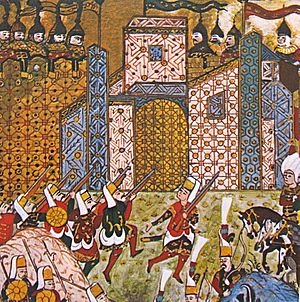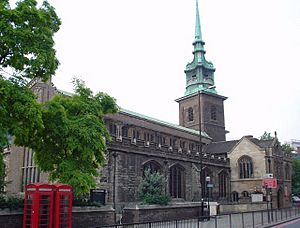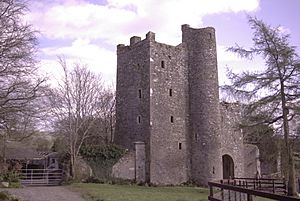John Rawson, 1st Viscount Clontarf facts for kids
John Rawson, 1st and only Viscount Clontarf (c. 1470–1547) was an important English leader in Ireland during the 1500s. He was the last head of the Kilmainham house for the Order of St John of Jerusalem. The Knights Hospitaller, as they were known, were a fighting order of monks. Rawson himself was an experienced soldier who took part in the Siege of Rhodes (1522).
Even though he was a monk, he had children. Later, during a big change called the Reformation, he gave all the Order's lands to the English King. In return, he received money and the title of viscount, becoming Viscount Clontarf.
Contents
Rawson's Family Background
John Rawson came from a family that had lived in New Fryston in England for a long time. His father, Richard Rawson, moved to London. There, he became an important city official and a leader in the Mercers' Company, a group of merchants. John's mother, Isabella Craford, passed away in 1497.
John had four brothers:
- Averey (or Alured) Rawson, who lived in Essex. His granddaughter Ann married Sir Michael Stanhope.
- Sir Richard Rawson (died 1543), who was a priest for the King and a church leader at Windsor Castle.
- Christopher Rawson, a merchant from Calais. His old brass monument from 1518 can still be seen at the church of All Hallows-by-the-Tower in London.
- Nicholas Rawson, who was in charge of a free chapel in Gressenhall, Norfolk.
Early Career and Public Service
John Rawson joined the Order of St. John of Jerusalem in 1497. In 1510, he went on an important trip to Rome and Venice to represent his country.
In 1511, he became the Prior of Kilmainham. This was a very powerful job in Ireland. It meant he could sit in the Irish House of Lords (a part of the government) and on the Privy Council of Ireland (a group of the King's advisors). Before Rawson, an Irish Prior had supported someone who wanted to be King of England instead of the real King. Because of this, the English government decided that only English people should be appointed as Priors of Kilmainham. In 1517, Rawson also became the Lord Treasurer of Ireland, managing the country's money.
Fighting at the Siege of Rhodes (1522)
The main home of the Order of St John of Jerusalem was on the island of Rhodes. When the Ottoman Empire tried to take over the island, Rawson was called to help defend it. In 1519, he was allowed to go to Rhodes for three years. However, things in Ireland became difficult, so Henry VIII (the King of England) told Rawson to come back in 1520 to help the Lord Deputy of Ireland (the King's representative).
In 1522, he got permission to go back to Rhodes. He is listed among the knights who were there fighting. Rhodes surrendered in December of that year. Rawson then returned to Ireland and got his old jobs back. In 1525, he traveled abroad again and spent some time in Italy. In 1527, he was put in charge of the Order's light soldiers. But King Henry VIII really needed Rawson's help in Ireland. So, he made sure Rawson was reappointed as Prior of Kilmainham and Treasurer of Ireland.

Later Political Influence
John Rawson was one of the most important members of the Irish Privy Council. People said he was part of a small "inner council of three" within the larger group. The other two were Patrick Bermingham, the chief judge, and John Alen, the Archbishop of Dublin. Rawson was described as "an able man and chief supporter of the government." He lived in a grand way.
He had disagreements with the Lord Deputy, Sir William Skeffington, and tried to get him removed from his job, but he was not successful. During a rebellion led by Silken Thomas, Rawson was one of the few important leaders who stayed loyal to the English King. Because of this, his lands were robbed. He was luckier than his colleague, Archbishop Alen, who was killed by Silken Thomas's men.
In 1535, Rawson was considered for the job of Lord Chancellor of Ireland, but he was not chosen because he was getting old and sick. He also argued with Skeffington's replacement, Leonard Grey, 1st Viscount Grane. Rawson was one of the people who helped bring about Viscount Grane's downfall in 1541.
Giving Up Kilmainham Priory
King Henry VIII decided to close down the Order of St. John of Jerusalem in England and Ireland. After long talks, Rawson agreed in 1541 to give up the Priory of Kilmainham. In return, he received a payment of 500 marks and the new title of Viscount Clontarf.
The Order's house at Kilteel, County Kildare, was given to Thomas Alen. Thomas Alen was a cousin of Archbishop Alen and had married Rawson's daughter, Mary. The impressive old tower house at Kilteel is still standing today. Lord Clontarf was an old and sick man by this time. He passed away in 1547, and his title ended with him.
It seems he had gathered a lot of money. His daughter Catherine brought a large amount of wealth to her husband, Rowland White. This included money and property in Ireland, Spain, Germany, and Flanders. Rowland was a merchant who built a successful business. Later, he lost a lot of money and was put in prison for debt. However, he then started a new and successful career as a writer about politics.
See also Clontarf Castle.
Rawson's Family
John Rawson had several children. The names of his known children are:
- Sir John Rawson.
- Mary, who married Thomas Alan (died after 1554) of Kilteel. Thomas was a government official and brother of Sir John Alan, who was the Lord Chancellor of Ireland. Mary and Thomas had at least one daughter, Eleanor, who married Robert Dillon, a chief judge in Ireland.
- Catherine, who married Rowland White. Rowland was a successful merchant and later an important person in Ulster in the 1560s. He also wrote several important books. Catherine and Rowland had three children, including John, who inherited the White family lands. Their daughter Margaret married Richard Delahide.



